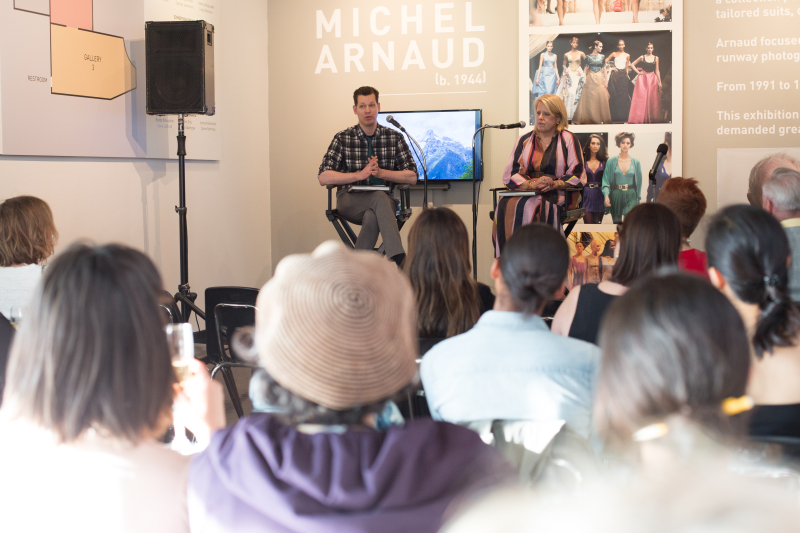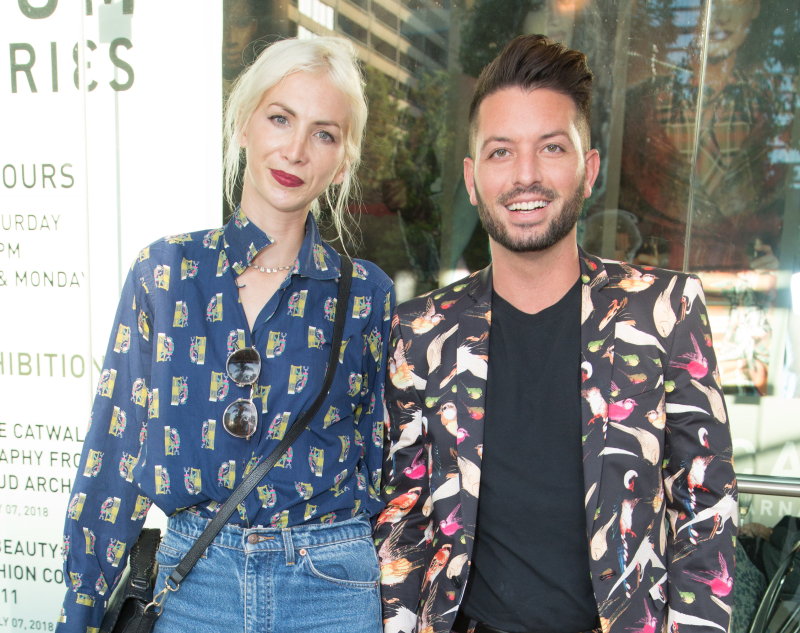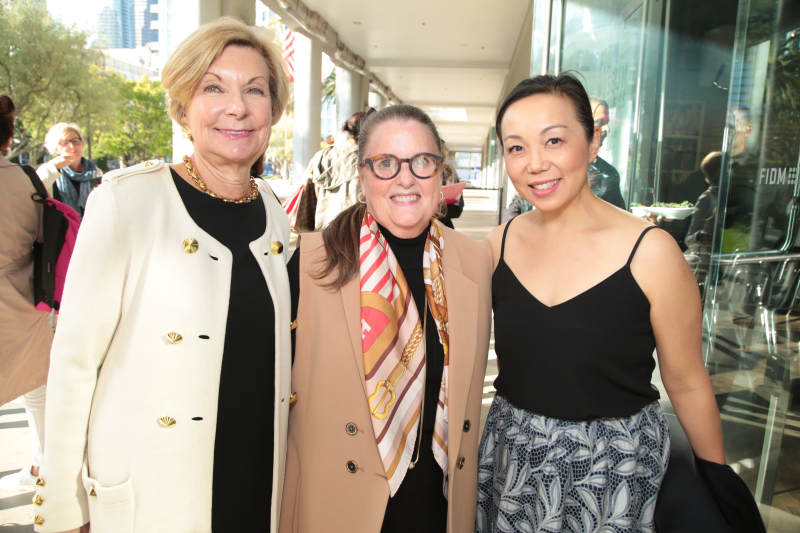Booth Moore signing copies of her book American Runway at the FIDM Museum
The Hollywood Reporter journalist and author Booth Moore recently visited the FIDM Museum for a reception in honor of her new book, American Runway. The CFDA published-book looks back at the tradition of New York Fashion Week, now celebrating its 75th anniversary. After a Q&A with students, moderated by Curator Kevin Jones, Moore took a tour of Capturing the Catwalk and sat down with us to talk about fashion journalism and the process of writing American Runway.
******************************************************************************************************************************************************************************
Let’s start at the beginning – can you tell us about your career path as a journalist?
I started writing for my high school newspaper. I had worked at some internships, and I was working at the Washington Post as an assistant for a columnist. I had a really big interest in fashion and wanted to migrate over to that, but I also really wanted to live in LA. So, I moved out to LA and had an introduction through my old boss at the Washington Post at the LA Times. I basically took the first job I could get at the LA Times and then just worked my way up to being the first fashion critic that the paper had ever had. I was there for 18 years covering all of the shows. I left and did a couple of books and freelanced, and now I work at The Hollywood Reporter. It’s fun because it’s working more closely with the entertainment industry, and also I run our style vertical online.
Did you find that you had to fight to speak about fashion critically?
There was an influential fashion editor before me at the LA Times, Mimi Avins, and even before that Mary Lou Luther – women who went to the shows all around the world and were able to critically look at fashion coming out of Los Angeles in that context. For me, when I would review shows that took place here, the opinions that I had weren’t always popular, but I think that it was an interesting time to write about fashion here. You had this whole different ethos of style. People were very much used to thinking of LA as a denim and t-shirt and swim and surf destination, and it was really the beginning of labels like Rodarte coming up that were more about artisanal hand crafted production. That was interesting to ride the wave of.
Curator Kevin Jones and Booth Moore conducting a Q&A discussion with FIDM students
Can you talk a little bit about the transition from working at the LA Times to The Hollywood Reporter? How did your focus shift when you moved to the entertainment industry?
I think it was something that was starting to happen in fashion anyway: celebrities becoming cover stars of magazines, sitting in the front rows of shows, having their own fashion collaborations, celebrities being models and models being celebrities. There was this crossover that had already started to happen. Now I feel like fashion is its own channel of pop culture, like music or movies. There is money to be made in Hollywood off fashion, and there is a lot of interest in how to make it. That’s one of the things I keep in mind with our coverage is just all of the business implications and opportunities. I also think that the ‘Hollywoodization’ of fashion has made it more accessible in some ways and for better or for worse sometimes engages people in different ways. My review of the Met Gala red carpet was maybe the most read thing on our website the day after. That I think is the perfect collision of Hollywood and fashion.
Booth Moore and Kevin Jones inside the Capturing the Catwalk exhibition
FIDM Museum Director Barbara Bundy with FIDM Department Chair Dina Morgan and Karen Kuo
How do you think social media changes what people are doing in fashion and on the runway? Do you think the immediacy changes things?
I think for some brands it ups the ante in terms of wanting to be more theatrical. I find myself watching social media and what’s trending. I think for these big brands that are spending many many millions of dollars on shows, they want to get as many eyeballs as possible. Again, that ups the ante of wanting to do something spectacular because that’s the way a lot of people are consuming fashion, on social media.
On the flip side of that, unfortunately sometimes I think fashion gets reduced to a social media moment or meme and if that’s all it is, it isn’t going to have very much of a future.
FIDM Museum Creative Director Peter Lam with FIDM Department Chair Lyn Tobman
Let’s talk about your new book American Runway. Why this book and why now?
The CFDA approached me to write it. They’ve wanted to do a history and happily the timing was right that it was going to be 75 years – actually in July – from the very first press week that they had in New York. There’s so much change happening on the runway now that it’s a good time to look back at where we came from, and posit a few questions about where we might be going. A few things that I was happy to learn more about were the role that women had in the beginning, establishing the industry and promoting it, the crossover with politics, and also just how the changes in the runway have gone hand in hand with changes in media and dissemination of information, all these kinds of larger cultural shifts that have affected a lot of things.
How did you do your research for the book?
I did a lot of it online. I did many interviews with designers and tastemakers, and luckily know a lot of journalists from covering the circuit of the shows for so long to rely on them. I had my own experience and my own body of work to rely on. I had a research assistant who was an NYU student who helped me in New York, and then I had a photo researcher. There were a couple of people who I would have loved to talk to that I didn’t. I really wanted to talk to Elsa Klensch; she had one of the first shows about fashion on television, which was on CNN in the 80s. A lot of people have fond memories of watching that, and it really brought high fashion to people’s living rooms pre-Project Runway. But she was too ill to do it. It would have been cool to talk to Calvin Klein. It was a fun project and could have gone on for much longer, but luckily we wanted the 75 year window!
Stylist Chelsea von Mach and FIDM Alumn and Stylist Daniel Musto at the reception celebrating American Runway
Is there a show that stands out for you when you think back about your personal experience of attending runway shows?
I think when it comes to New York, certainly the Marc Jacobs show the night before September 11 was a big contrast moment for a lot of people because it was on the pier on the west side. The twinkling lights of Manhattan, it was so beautiful and peaceful. Things changed so much the next day. A lot of Marc’s shows have been memorable. What’s interesting about him is that he never really likes to explain his shows or his collections; he really wants people to come up with their own interpretations. In terms of shows from other cities, Dries van Noten had an anniversary show where the runway was a huge dinner table, and the models walked down the table and dinner was served. At the end these huge shelves came down in front of everyone, and a copy of his book was in front of each table setting. Some of the Chanel shows too with the iceberg and otherworldly settings.
FIDM Museum Associate Joanna Abijaoude with Booth Moore
Can you tell us your reaction to seeing our Capturing the Catwalk exhibition?
I thought it was so cool – it really brings fashion to life in a different way when you are able to see these garments in person, and also see the photo of them on the runway. So many of the pieces are so iconic, some of the Versace looks and the Issey Miyake beautiful folded coat. It’s really an extraordinary exhibition! It also reminded me of some of the photographers I talked to [for the book] who used to shoot pre-digital, and the logistics of that. They told me how at the end of a runway show there would be film canisters knee deep that they would be wading through. Also just how physical taxing it was for the photographers to work the shows four to five weeks at a time.




Thank you for sharing this! Just what I’ve been searching for. Great info!